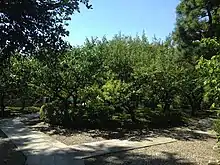| Bairin-ji (Zen Temple) 梅林寺 | |
|---|---|
 Main Gate (sanmon gate) of Bairin-ji | |
| Religion | |
| Affiliation | Myōshin-ji Rinzai Zen |
| Location | |
| Location | Kyo-machi 209, Kurume, Fukuoka Prefecture |
| Country | Japan |
| Geographic coordinates | 33°19′24″N 130°29′58″E / 33.3233°N 130.4995°E |
| Architecture | |
| Founder | Arima Toyōji |
| Completed | 1621 |

Bairin-ji (梅林寺) is a Rinzai temple in Kurume, Fukuoka Prefecture, Japan. Its honorary sangō prefix is Kōnanzan (江南山). It is known as a representative training dojo temple of the Myōshin-ji school in Kyushu which faces the clear stream of the Chikugo River.[1]
History

The temple was originally located in Fukuchiyama and called Zuigan-ji (瑞巌寺). In 1620, however, Arima Toyōji (有馬豊氏) who was transferred from Fukuchiyama Domain (福知山藩) in the Tanba Province to Kurume Domain, started to move to the present location in the following year. Later it was renamed to Bairin-ji which is associated with his father Noriyori's posthumous name, Bairin'in-den (梅林院殿) and became a mausoleum of the successive Kurume Domain. There remains a grave of the Arima clan, including Toyōji.
Cultural properties
The temple is a treasure trove of some 600 cultural assets. The collection includes the silken hanging scroll of three Buddhas called Shaka Sanzon (釈迦三尊) and a painting of Mt. Fuji by renowned Edo-period painter Ogata Korin (1658-1716).[2] Other Edo period cultural assets in the temple are folding screens from Tohaku Hasegawa, and fusuma (Japanese sliding door) paintings in the Kano style.[3] The colored silk wooden Avalokiteśvara statue in the main hall is the work of the Kamakura period.
Garden and plum blossoms

The Gaien (外苑) is a garden which is adjacent to Chikugo River side to the north side. Approximately 30 species of 500 plums donated by the citizens, and many azaleas are planted in the garden. It was opened as a park in 1958 to commemorate the 350 years old of the founding priest, Umon Genkyū Zenji (禹門玄級禅師).[4]
The temple's name, Bairinji, translates to Plum Grove Temple. The plum trees, flower mid-February to mid-March, adding a streak of pink and white to the temple grounds. The blossoms are quite fragrant, and many visitors go to the temple to enjoy a cup of tea and sweets beneath the flowering trees.[5]
Bairinji as a meditation center
Bairinji Temple is regarded as the main zen temple in Kyushu where regular meditation is practiced and taught to monks and lay people. The monastery was opened in 1804, and it flourished as a training monastery (修行道場), but it fell into disrepair due to the strong influence of the Meiji anti-Buddhist movement. It was reopened in year 1879 by Masters Sanseiken (三生軒) and Toukaiyuzen (東海猷禅), who served as the chief priest (abbot).[6]
Around the end of the 19th and the beginning of the 20th century, Bairinji was famed between monks as one of the two most demanding zen monasteries in Japan (the other one being Shogenji in Gifu Prefecture).[7]
References
- ↑ 梅林寺[臨済宗妙心寺派][福岡県久留米市京町209]-お寺めぐりの友 [Bairin-ji] (in Japanese). hakataboy.com. Retrieved October 4, 2018.
- ↑ 梅林寺 [Bairinji Temple] (in Japanese). Japan Online Media Center. Retrieved December 6, 2023.
- ↑ Bairin-ji Temple - Kurume Convention Bureau
- ↑ 梅林寺 [Bairin-ji] (in Japanese). Kurume Convention Bureau. Retrieved October 4, 2018.
- ↑ 梅林寺 [Bairinji Temple] (in Japanese). Japan Online Media Center. Retrieved December 6, 2023.
- ↑ 「昭和平成禅僧伝 臨済黄檗篇」臨済会編 春秋社発行 2010年 146p 関連法系図の表7
- ↑ Living and Dying in Zazen - Book written by Arthur Braverman (Living and Dying in Zazen - Five Zen Masters of Modern Japan pp.99-100)
External links
- Bairin-ji Temple - Kurume Convention Bureau
- Public Domain Image of the 14th Century Shaka Triad Scroll - Public Domain Host Picryl